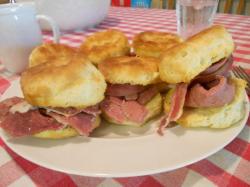An American Ham
October 13, 2010 | 1 min to read

How did people preserve meat before the days of refrigeration? They salted it, dried it, and smoked it! In America we still keep a few “leftovers” from the old days of salted meat in our fridges today. One of these everyday salted meats is bacon and another is country ham, the best known of which is the Smithfield Ham!
On our journey through Virginia, Amanda and I visited the town of Smithfield, where the manufacture of Smithfield Ham began and where today, as stated by law, all Smithfield Hams must be made within the city limits. We discovered that Smithfield Ham is a specific brand of country ham.
Country hams are dry cured hams that have been aged for a minimum of 25 days. Most country hams are aged from 2-3 months. Smithfield Hams, as a benchmark of the highest quality county ham, are aged from 6-12 months before packaging.
To read the rest of the story, please go to: Chefs On The Road.
